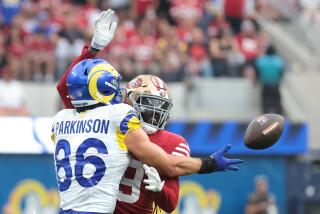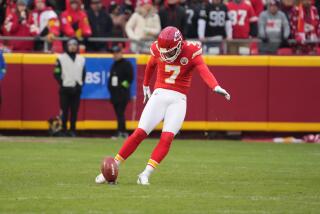Pro Football : With Rules Favoring Offenses, Teams Are Piling Up the Points
- Share via
CINCINNATI — Life in the National Football League used to begin at 40. You could count on winning with 40 points.
Today, not necessarily.
It has been a big scoring year so far in the NFL, unusually big. To the sports fans who think a scoreless tie is a fate worse than a soccer game, the football season is off to a beautiful start.
Is there a reason?
“Yes, there is, but it’s not a very glamorous reason,” Sam Wyche, coach of the Cincinnati Bengals, said this week. “The offensive coaches have been getting the breaks in the rules for the last several years. This year, we’re simply putting (it all) together.”
As a consequence of the rules changes of recent years:
--Most holding is legal now.
--The passer can’t be touched if the tackler has to take even one step before hitting him after the ball is gone.
--And, among other things, the downfield bump-and-run has been outlawed, encouraging the NFL’s offensive coaches to find more quick little receivers and 300-pound offensive linemen to wall off the passer.
Finally taking advantage of all this, NFL teams are instructing their quarterbacks to fire more rapidly this season--dropping back only three to five steps, instead of seven.
And more than ever, coaches are putting four receivers on the field at the same time, doubling the number of passing targets. And taking defensive backs as well as linebackers out of the pass rush.
Thus, the rush is being neutralized. The offensive wall is just that now, human but massive, and sacks are down dramatically. There will be fewer than 1,000 sacks this season for the first time since they started counting.
“(Offensive coaches) are combining our many blessings this year, our many advantages,” Wyche said.
Some of UCLA’s prominent recent stars have had trouble getting out of the starting gate in pro ball.
Halfback Gaston Green, the Rams’ top choice in the renowned Eric Dickerson trade, has proved that he’s no Dickerson.
Troy Aikman, the Dallas Cowboys’ $11-million quarterback, is a remarkable short passer who doesn’t throw it long enough to worry NFL defenses.
Who’s left? Well, there’s Cincinnati’s rookie fullback, Eric Ball--a Bruin product who is a pro. Or so he looked Monday night when he replaced the injured dancer, Ickey Woods, and was the game’s leading rusher with 78 yards in 18 carries.
“Before the game, I told Eric: ‘This is the night you burst onto the NFL scene,’ ” his new coach, Wyche, said enthusiastically. “And sure enough, he did.
“For the average good rookie back, you’d eliminate the no-huddle offense until he’d been around a while. But we didn’t change anything, we didn’t condense anything for Eric, and he didn’t miss a beat.
“(Quarterback) Boomer (Esiason) called every play at the line of scrimmage, and we had an extensive audible system. It wasn’t just, ‘Check with me, left or right.’ It was basically our whole offense, and Eric got every signal dead right. For a rookie, that was amazing.”
And so the difference between the Bengals and most passing teams remains. They can run the ball--with Woods and James Brooks last season, with Ball and Brooks now.
“Nobody runs better (than Cincinnati),” said Cleveland’s new coach, Bud Carson. “I would rather play Cincinnati less than anyone, for that reason.”
How much will the Bengals miss Woods?
“We’ll miss the heck out of him,” said Wyche. “But the fact is, Eric had a better preseason than Ickey.”
Beginning his coaching career impressively at the age of 57, Carson came to Cincinnati undefeated this week, bringing his old 4-3 Pittsburgh defense with him--the one that made middle linebacker Jack Lambert famous when an All-Pro defensive tackle, Mean Joe Greene, stripped out most of the other team’s inside blockers.
Carson coaches to take the middle away from the offense. His defensive tackles crouch closely together, making a run between them virtually out of the question.
Yet on Cincinnati’s ground play of the night, Ball accelerated so rapidly--after accurately interpreting Esiason’s audible signal--that he zipped between Cleveland’s tackles for 11 yards, pulling the Bengals out of a hole near their end zone in the first quarter, and positioning them for a big second quarter.
Hefty enough at 211 pounds, Ball, who stands 6 feet 2, went on to gain 78 yards. After the statisticians subtracted the end-around yardage compiled by wide receivers on both sides, Ball outgained the Cleveland team in rushing.
Ball said: “Our trap blocking up the middle was fantastic.”
On the night of his NFL debut, what was Ball thinking?
“As many times as I found myself going one on one against a (defensive back),” Ball said, “ I was thinking, ‘Maybe I should have done this or this to get a bigger play.’ ”
If there’s a Dickerson ego there, it’s under control.
In their last two games, the San Francisco 49ers have won without running the ball effectively.
That’s the biggest difference in the 49ers in the post-Bill Walsh era.
With the same defensive coach, George Seifert, who has replaced Walsh as head coach, the 49ers have the same defense.
And with Joe Montana, they have the same pass offense. After 11 years in San Francisco, Montana knows the pass offense so well that he’s like a Bill Walsh computer chip.
But you don’t win three Super Bowls with a one-dimensional coach, and Walsh was never that. Indeed, he was probably the greatest all-around coach of his time--an underrated motivator, a skillful drafter, the most creative thinker, and the surest road-game winner since George Allen.
And he based the whole operation on a strong running game.
This year, with Coach John Robinson in his prime, the Rams are running with more success than the 49ers--even though no one would ever trade Roger Craig even up for Greg Bell.
What’s more, in his better moments, Jim Everett has passed the ball with an artistry reminiscent of Montana, employing Henry Ellard as productively as Montana uses Jerry Rice.
On defense, also, these undefeated old rivals seem about even--but as running teams, there’s no comparison.
If the past is prologue, the Rams will win in San Francisco Sunday because the 49ers have forgotten how to run.
The Philadelphia Eagles, at the moment, aren’t getting the most out of their gifted young quarterback, Randall Cunningham.
With a chance to open a sizable lead against the 49ers Sunday, and make a Montana-led comeback impossible--well, more unlikely--they chained Cunningham in the pocket, and tried to win on conventional running plays with their substandard runners.
As a roll-out quarterback, Cunningham leads the league today as both passer and ballcarrier. He also leads in the science of running quarterback draws from the pocket. But in the 49er game, the Eagles called for none of that--even on the goal line, where, three times, they were well positioned for the touchdowns that would have blown the 49ers out.
Two years ago, Cunningham criticized Coach Buddy Ryan for conservative signal-calling, and this week he stopped just this side of doing it again. With a touch of sarcasm, he said of the Philadelphia roll-out play: “It’s still in the play book.” Long pause. “But I don’t want to get controversial.”
Ryan has been exemplary in the task of bringing along a brilliant young quarterback. He championed him publicly from the start. Early on, he imaginatively threw Cunningham in as a third-down quarterback--for the experience. And, this summer, he let him call the plays, giving him a feel for strategy that a quarterback can gain no other way.
But in Sunday’s game, the truth is, Cunningham wasn’t playing in a modern NFL offense. Montana didn’t outplay Cunningham. He outplayed Ryan.
More to Read
Go beyond the scoreboard
Get the latest on L.A.'s teams in the daily Sports Report newsletter.
You may occasionally receive promotional content from the Los Angeles Times.










